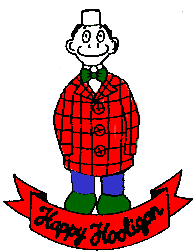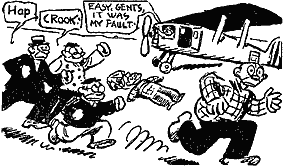The "Happy Hooligans"NDANG
 Possibly
no other Air National Guard unit has a nickname as well known as "The
Happy Hooligans". Where did that nickname come from? How did it come about?
Possibly
no other Air National Guard unit has a nickname as well known as "The
Happy Hooligans". Where did that nickname come from? How did it come about?
Our 178th Squadron Commander in the mid 1950's was Duane S. Larson (Brig. Gen., Ret.). Because of his fatherly instincts, (then Major) Larson became known as "Pappy" to his entire squadron. His men were dubbed "Hooligans" for their mischievous antics. Locally they became known as "Pappy and his Hooligans". Because of his striking resemblance to the Steve Canyon comic strip character, "Happy Easter", the squadron was soon known as "Happy and his Hooligans", and later shortened to "The Happy Hooligans" (around 1958). Soon everyone around the base was using the nickname "Happy Hooligans" to describe the squadron.
In the early 1960's, the North Dakota Air Guard was searching for a motto to set them apart from other units (similar to the Pittsburgh motto: "Have No Fear, A Sam Is Near"). A contest was held to choose an official nickname; no names received topped "The Happy Hooligans", so it was officially adopted as our unit's nickname.
In 1964, during the ANG Rick's Trophy competition, "The Happy Hooligans" was painted on the unit's F-89J's. This was the first time it appeared on the aircraft, but since then each North Dakota Air National Guard aircraft has carried that motto prominently displayed.
After our nickname gained national renown, the question was raised concerning a cartoon character bearing the same name. Some investigating turned up the following facts:
 The
comic strip "Happy Hooligan" was created by Frederick Burr Opper and made
its debut in Hearst's Sunday comic sections in New York and San Francisco
on March 26, 1900, and ran intermittently until 1932, when Happy Hooligan
had to be abandoned by its creator because of his failing eyesight.
The
comic strip "Happy Hooligan" was created by Frederick Burr Opper and made
its debut in Hearst's Sunday comic sections in New York and San Francisco
on March 26, 1900, and ran intermittently until 1932, when Happy Hooligan
had to be abandoned by its creator because of his failing eyesight.
Happy Hooligan was Fred Opper's classic Irish tramp with the tin can hat and distinctly ruddy nose. He was portrayed as the simple innocent whose impulsive undertakings nearly always landed him in the hands of the law. Despite his continual ill luck, Hooligan lived up to his name by remaining always optimistic, and his enormous smile became a quick symbol of the new comic strip art form to millions of readers.
Frederick Opper drew comic strips for Hearst papers from 1900 to 1936. He was born on Jan. 2, 1857, and died on Aug. 29, 1937. He also did illustrations for, among others, Mark Twain.

In 1899 one of the most extraordinary and prolific artists of that age in which good artists were so numerous made his debut in the comic-strip world. His name was Frederick Burr Opper, and his first strip was called "Happy Hooligan" Happy Hooligan is a clown‹but a sad clown. His amorphous face, his resigned smile, and the empty can that serves him as a hat plainly stamp him as a victim. He is the quarry of children, the target of hooligans, a goat for all and sundry. His tribulations are as ludicrous as they are pathetic, and while he manages to survive, his ephemeral triumphs are only illusory. In the person of Happy, we can already recognize the tentative outline of the "little man" later made immortal by Chaplin. Among Opper's numerous other creations, "And Her Name Was Maud!" and "Alphonse and Gaston" (both of which date from 1905) are worthy of special note.